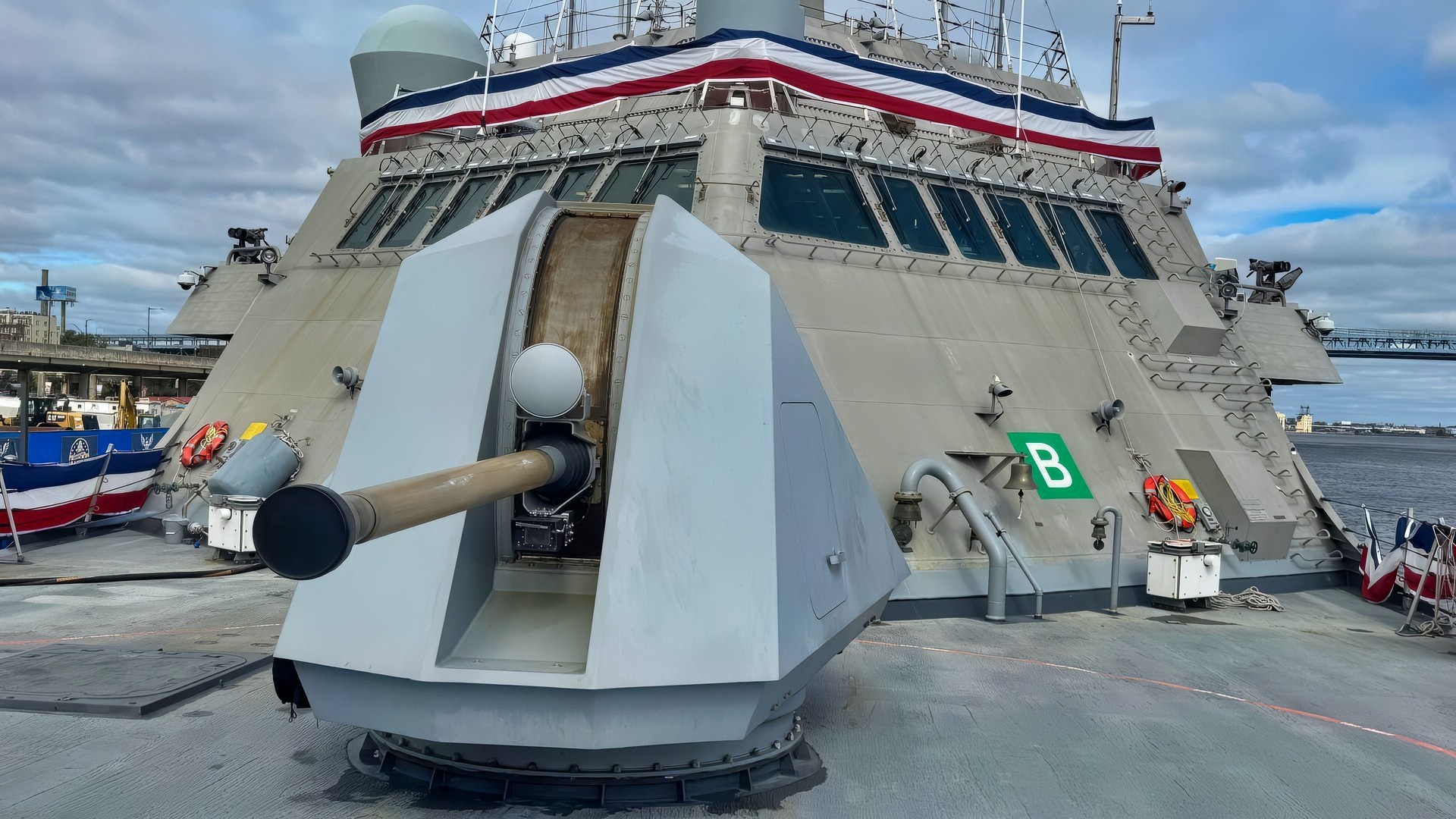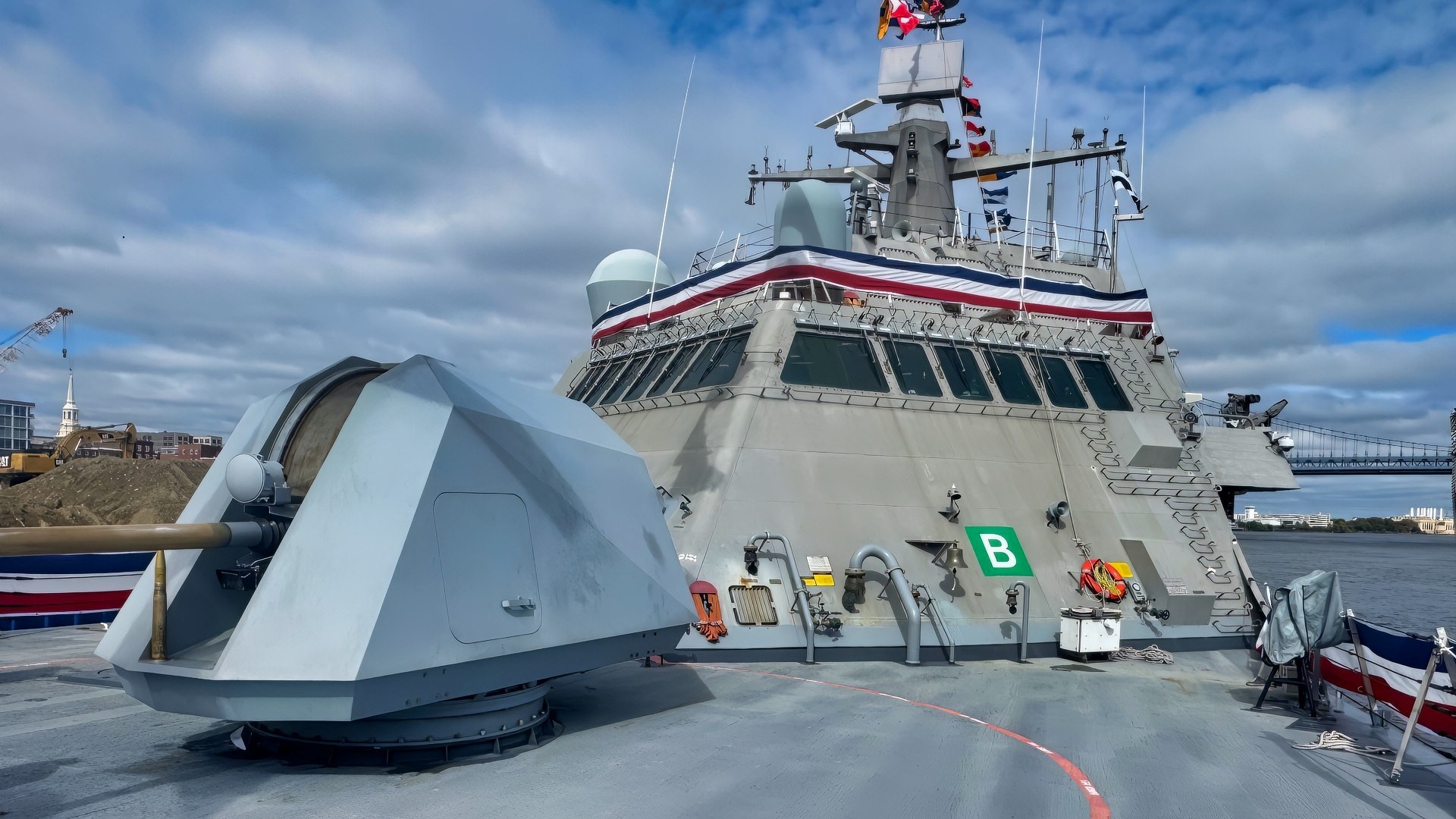Key Points and Summary – The U.S. Navy is moving to retire several Littoral Combat Ships after barely a decade in service, an unusually early exit for frontline warships.
-Conceived as fast, modular coastal combatants, the LCS was supposed to swap mission packages for mine-hunting, anti-submarine warfare, and surface warfare.

Littoral Combat Ship Deck National Security Journal Image by Stephen Silver.

Littoral Combat Ship Deck Gun U.S. Navy. Image Taken by National Security Journal on October 14, 2025.
-In reality, key modules slipped years behind schedule, reliability and survivability problems piled up, and fixes proved costly.
-A major engineering defect in the Freedom-class combining gear further undermined confidence.
-With modern threats demanding more capable, better-armed surface combatants, the Navy has concluded it’s cheaper and faster to divest LCS and shift investment to the new Constellation-class frigates.
–National Security Journal recently toured the Littoral Combat Ship USS Billings and presents original photos from that visit in this article.
Why the Navy is Retiring Littoral Combat Ships Faster Than Ever
The U.S. Navy is moving to retire multiple Littoral Combat Ships (LCS) well before the end of their expected service life, and it’s an extraordinary reversal.
The plans involve vessels that entered the fleet barely a decade ago – shocking, considering the fact that the U.S. Navy still sails warships that are decades old.
In its FY 2025 budget request, the U.S. Navy asked Congress for permission to decommission 19 ships, including two Independence-class Littoral Combat Ships – USS Jackson (LCS-6) and USS Montgomery (LCS-8) – despite both being less than 12 years old.
Jackson was commissioned in 2015, and Montgomery in 2016, meaning each would leave service roughly a decade into what was initially planned as a 25-year service life. The reason? High life-cycle costs and limited operational utility.
This kind of early retirement is almost unheard of in modern American naval history. Destroyers, cruisers, and amphibious ships routinely serve 30-40 years.
So what went wrong?

Littoral Combat Ship USS Cooperstown. Image Taken By National Security Journal October 14, 2025.

Littoral Combat Ship USS Cooperstown NSJ Photo Taken On October 14, 2025.

Top of USS Cooperstown Littoral Combat Ship. Taken by National Security Journal on October 14, 2025.
Well, while it may be argued that it was a matter of poor planning, it’s also reflective of just how rapidly the threat environment and the U.S. Navy’s needs are changing.
The LCS Concept – And Why It Failed
The Littoral Combat Ship was conceived in the early 2000s as a small surface combatant optimized for operations in contested coastal waters, with primary missions including antisubmarine warfare (ASW), mine countermeasures (MCM), and surface warfare (SUW), particularly in littoral, near-shore environments.
The Navy officially began procuring the LCS in FY 2005 and ultimately bought 35 ships through FY 2019. The ships’ design focused heavily on high speed – achieving more than 40 knots, to be specific – as well as a shallow draft, meaning the vessel did not extend greatly below the surface of the water.
The design made it ideal for operating in coastal waters and ports inaccessible to larger cruisers and destroyers.
Instead of a single hull, the Navy also selected two distinct variants.
The steel-hulled Freedom-class featured a monohull, and the Independence-class was made of aluminium.
Design work began in 2004 in parallel with the development of modular mission packages, and the Pentagon ultimately chose not to “down-select” a single design, intending for both classes to be built at the same time.
The choice, officials say, was political. According to former Navy undersecretary Robert Work, the decision was intended in part to secure congressional support for the program, and not because the Navy considered it necessary or even wise.
The core idea was this: each LCS would carry a swappable mission package – MCM, ASW, or SUW – that can either be installed or removed in port, allowing a single hull to shift roles on the fly. But in practice, it didn’t work out as intended.
The Government Accountability Office found that those mission modules remained years behind schedule, with the Navy failing to demonstrate for years that the ships could perform their intended missions.
A review from 2022 concluded that the LCS fleet had “not demonstrated the operational capabilities it needs to perform its mission.”
“Operational testing has found several significant challenges, including the ship’s ability to defend itself if attacked and failure rates of mission-essential equipment. The Navy is also behind schedule in developing the various mission modules—different configurations of key systems for different missions, such as mine countermeasures—for the LCS. In addition, GAO found that the LCS has frequently encountered challenges during deployments,” the report continued.
Reliability and survivability problems also appeared early.
In 2015, the GAO also reported that LCS lethality and survivability were still largely unproven six years after delivery of the lead ships, and that the Navy had lowered several survivability and lethality requirements – and even removed several design features.
And then there were the mechanical defects that compounded all those problems. The Freedom-class suffered a class-wide defect in its combining gear – a complex transmission that connected its gas turbines and diesel engines to the propulsion shafts.
The problem led the Navy to halt the delivery of new ships until a fix was identified.
Reports later revealed that repairing the defective combining gears could cost between $8 million and $10 million per ship.
And this isn’t even the whole picture.
It’s not hard to see why the Navy is retiring the ships now.
The fixes cost more than the value they would add, and upgrading the LCS to meet modern anti-ship missile and submarine threats would also require new sensors, weapons, and reliability overhauls that Navy leaders appropriately argue are fiscally unjustifiable.
Instead, funding is now being redirected to the more capable Constellation-class frigate, which will field Aegis-compatible sensors, 32 vertical-launch cells, and a full ASW suite – capabilities that the LCS cannot economically achieve.
In practice, the Navy has concluded this: the fastest way to close its capability gaps is to retire the LCS and replace it outright.
About the Author:
Jack Buckby is a British author, counter-extremism researcher, and journalist based in New York who writes frequently for National Security Journal. Reporting on the U.K., Europe, and the U.S., he works to analyze and understand left-wing and right-wing radicalization, and reports on Western governments’ approaches to the pressing issues of today. His books and research papers explore these themes and propose pragmatic solutions to our increasingly polarized society. His latest book is The Truth Teller: RFK Jr. and the Case for a Post-Partisan Presidency.
More Military
The F-35 Fighter Is In More Trouble Than You Think
Was USS Wasp Really the Worst U.S. Navy Aircraft Carrier?
The Navy Had a Nuclear Submarine That Could Tap Russia’s Undersea Cables and Self Destruct
The U.S. Navy’s Flying Aircraft Carrier Mistake Still Stings










